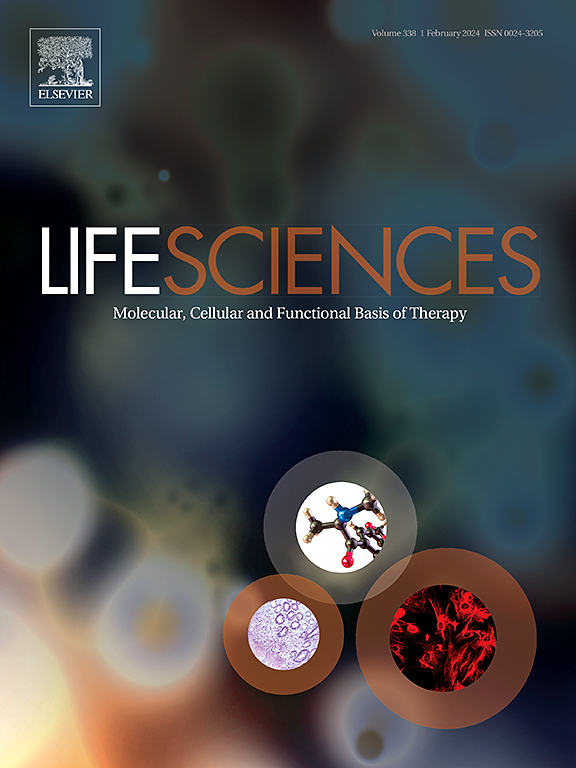FAM172A缺失通过eIF2α-ATF4-FGF21回路加重高脂肪饮食诱导的MASLD
IF 5.1
2区 医学
Q1 MEDICINE, RESEARCH & EXPERIMENTAL
引用次数: 0
摘要
目的抑制内质网应激(ERS)可有效改善代谢功能障碍相关脂肪变性肝病(MASLD)的进展。在本研究中,我们试图进一步探讨Fam172a在高脂肪饮食(HFD)诱导的masld中的作用机制。材料与方法采用WB和qRT-PCR检测FAM172A与ers诱导的MASLD的相关性。我们利用野生型(WT)和Fam172a基因敲除(Fam172a−/−)小鼠建立了HFD诱导的MASLD模型和tunicamycin (Tm)诱导的ERS模型。我们评估了肝脏炎症、脂肪变性和脂质积累的程度,以及ERS和凋亡的关键分子(Bax/Bcl-2)。基于RNA-seq分析,我们验证了Fam172a的下游靶分子。采用共免疫沉淀法探索Fam172a的结合蛋白及其核心功能片段。我们发现患有MASLD的Fam172a−/−小鼠表现出明显的肥胖、糖脂代谢功能障碍、严重的肝脏炎症和脂肪变性以及ERS通路激活。在ERS小鼠模型中也发现了类似的结果。我们还发现Fam172a−/−可能通过激活真核翻译起始因子2α (eIF2α)显著上调成纤维细胞生长因子21 (Fgf21)的表达。FGF21可以部分抵消Fam172a缺失诱导的ERS和肝脏脂肪变性。Fam172a 1-102氨基酸是与eIF2α相互作用的核心区域。fam172a基因缺失可通过eIF2α-ATF4途径促进hfd诱导的MASLD。通过eIF2α-ATF4通路上调Fgf21的表达,通过负反馈回路部分抑制Fam172a基因缺失的作用。因此,FAM172A可能是MASLD的潜在靶点。本文章由计算机程序翻译,如有差异,请以英文原文为准。
FAM172A deletion aggravates high fat diet-induced MASLD via the eIF2α-ATF4-FGF21 loop
Aims
Inhibition of endoplasmic reticulum stress (ERS) can effectively improve the progression of metabolic dysfunction-associated steatotic liver disease (MASLD). In this study, we attempted to further explore the mechanism of Fam172a in high fat diet (HFD) induced-MASLD.
Materials and methods
The correlation between FAM172A and ERS-induced MASLD was tested by WB and qRT-PCR. We utilized wild type (WT) and Fam172a gene knockout (Fam172a−/−) mice to build two models: MASLD model induced by HFD and ERS model induced by tunicamycin (Tm). We evaluated the degree of liver inflammation, steatosis, and lipid accumulation, and key molecules of ERS and apoptosis (Bax/Bcl-2). Based on RNA-seq analysis, we verified downstream target molecules of Fam172a. Co-immunoprecipitation was used to explore the binding protein of Fam172a and its core functional fragment.
Key findings
We have found that Fam172a−/− mice with MASLD shows significantly obesity, dysfunction of glucolipid metabolism, severe hepatic inflammation and steatosis, and ERS pathway activation. Similar results are found in the ERS mouse model. We also reveal that Fam172a−/− may significantly up-regulate fibroblast growth factor 21 (Fgf21) expression, probably through activating eukaryotic translation initiation factor 2 alpha (eIF2α). FGF21 can partly counteract Fam172a deletion-induced ERS and hepatic steatosis. Fam172a 1–102 amino acids is the core region to interact with eIF2α.
Significance
Fam172a gene deletion can promote HFD-induced MASLD via the eIF2α-ATF4 pathway. The expression of Fgf21, up-regulated by the eIF2α-ATF4 pathway, partially inhibit the effects of Fam172a gene deletion via negative feedback loop. Thus, FAM172A may serve as a potential target of MASLD.
求助全文
通过发布文献求助,成功后即可免费获取论文全文。
去求助
来源期刊

Life sciences
医学-药学
CiteScore
12.20
自引率
1.60%
发文量
841
审稿时长
6 months
期刊介绍:
Life Sciences is an international journal publishing articles that emphasize the molecular, cellular, and functional basis of therapy. The journal emphasizes the understanding of mechanism that is relevant to all aspects of human disease and translation to patients. All articles are rigorously reviewed.
The Journal favors publication of full-length papers where modern scientific technologies are used to explain molecular, cellular and physiological mechanisms. Articles that merely report observations are rarely accepted. Recommendations from the Declaration of Helsinki or NIH guidelines for care and use of laboratory animals must be adhered to. Articles should be written at a level accessible to readers who are non-specialists in the topic of the article themselves, but who are interested in the research. The Journal welcomes reviews on topics of wide interest to investigators in the life sciences. We particularly encourage submission of brief, focused reviews containing high-quality artwork and require the use of mechanistic summary diagrams.
 求助内容:
求助内容: 应助结果提醒方式:
应助结果提醒方式:


